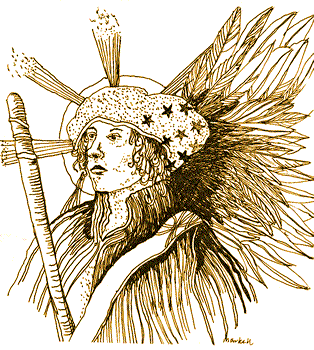| |
 Saint
Michael: Saint
Michael:
Warrior from Heaven
by Mary C. Earle
Portrait
of St. Michael by Sally Markell
St. Michael the Archangel is no sweet cherub. He is traditionally
known as the commander-in-chief of the heavenly host, a strong warrior
and a presence who presides from on high.
In
the Hebrew Scriptures, we find him in the Book of Daniel in chapters
10 and 12, where he is referred to as “the great prince, the
protector of your people” (Dn. 12:1). In the Revelation to
John, the last book of the New Testament, Michael figures prominently
in the great war in heaven: “And war broke out in heaven,
Michael and his angels fought against the dragon.” (Rev. 12:7)
Along
with Gabriel, Raphael and Uriel, Michael is one of the four archangels
revered in Christian tradition. Traditionally
Michael (whose name means “one who is like God”) is
known as a divine messenger, a protector of the faithful, the angel
who guides our souls upon death. Often depicted
with sword in hand, subduing a dragon or with a snake beneath his
feet, Michael represents divine strength and courage in the face
of evil. He is the patron of the sick, a champion for those who
are weak, a defender of the oppressed and the righteous. Soldiers,
grocers, radiologists and police are among the many who claim Michael
as their patron.
Michael
has held a special place of honor and reverence in the Celtic Christian
tradition. My husband and I discovered this some years ago when
we made a pilgrimage to western Ireland. There we became aware of
Michael as one who dwells in the midst of the wild energy of sea
and wind at the ancient monastic site of Skellig Michael. In the
midst of the turbulent currents off the southwest coast of Ireland,
the tiny island of Skellig Michael juts up abruptly from the white
sea-spray. Centuries ago, hardy monks devoted to Michael lived on
that rocky wilderness, buffeted by gales. Living in their stone
huts on this eerie crag of rock, the monks named their community
after the great Archangel, perceiving in their life and in their
vocation a call to dwell in the wild forces of God’s creation,
on that old eternal rock, learning to love each other and God through
prayer and work.
In the Celtic lands of Ireland, Scotland, Wales, Cornwall and Brittany,
various high places are dedicated to St. Michael—Mont St.
Michel off the northwest coast of France, for example. On the Isle
of Skye, off the northwest coast of Scotland, Michael was honored
on September 29 with “St. Michael’s bannock,”
a kind of bread made with the grain from the harvest. Cakes and
other foods were brought to the church and blessed, then distributed
to the poor. In this way the congregants participated in Michael’s
own protection of Christ’s cherished poor and sick.
The
feast was also marked by racing, and by the “appropriating”
of horses for the day. (If you did not have a horse, and you wanted
to race, it was permitted on this day for a man or a woman to “borrow”
a neighbor’s horse for the racing.) The race was accomplished
without bridles or saddles, in imitation of the depictions of Michael
riding bare-back without a bridle. Among the people of the Hebrides,
Michael represented risk- taking energy, offered on behalf of others.
He was invoked on journeys, on pilgrimage, and during the process
of dying.
The
prayers from the Hebridean tradition invoke Michael’s protecting
presence:
O
Michael of the angels
And the righteous in heaven,
Shield thou my soul
With the shade of thy wing;
Shield thou my soul
On earth and in heaven;
From foes upon earth,
From foes beneath earth,
From foes in concealment.
Protect and encircle
My soul ‘neath thy wing,
Oh my soul with the shade of thy wing.
(Carmina Gadelica III, 149)
Among
the Celtic peoples there was a clear awareness that, even though
creation is good and comes from God’s own goodness, evil is
in the world. They understood the patristic teaching that God’s
gracious gift of freedom, which always allows us the room to choose
life or to choose death, brings with it the risk of our choosing
evil. Archangel Michael was
invoked as a defender of body and soul from forces within and without.
Michael and the host of heaven were called upon in the face of “spiritual
forces of wickedness that rebel against God,” and “the
evil powers of this world.” (Book of Common Prayer,
p. 302)
As
an angel of God, Michael rides the winds of God’s creative
goodness, serving the living Christ, the Word through whom all comes
to be. Michael accompanies us in the twists of life’s journey
and the passage of death, sometimes known in the Celtic tradition
as “the river hard to see”. He is with us at the beginning,
with us at the end:
Thou
chief of chiefs,
Thou chief of the needy,
Be with us in the journey
And in the gleam of the river;
Be with us in the journey
And in the gleam of the river.
(Carmina Gadelica III, 145)
©2006
Mary C. Earle |




